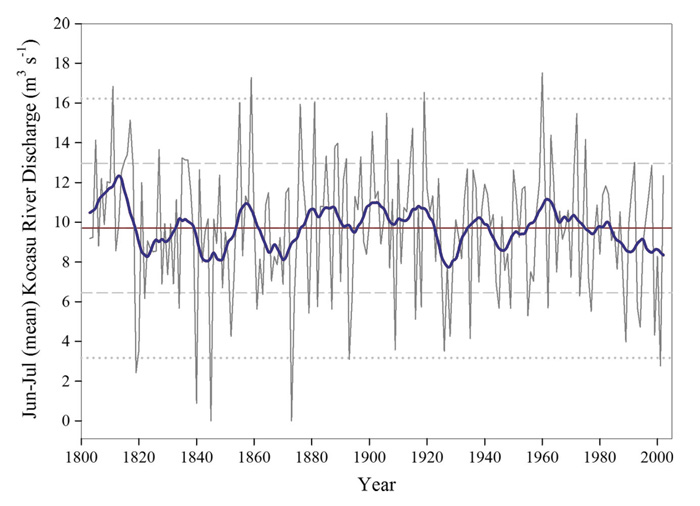| Follow @co2science |
Paper Reviewed
Güner, H.T., Köse, N. and Harley, G.L. 2017. A 200-year reconstruction of Kocasu River (Sakarya River Basin, Turkey) streamflow derived from a tree-ring network. International Journal of Biometeorology 61: 427-437.
Proxy records of streamflow are important because they can provide a clearer view of the range of natural variability beyond that seen in historical or observational records. Recognizing and understanding that natural variability is key to both making and evaluating future streamflow predictions, as well as in determining whether or not there is an emerging human-induced signal in a given record.
In this regard, two extreme droughts occurred in Turkey in 1989 and 1994, placing a severe economic and social strain on the entire country. However, it is difficult to ascertain to what degree those droughts may or may not have been influenced by anthropogenic climate change because the instrumental record of such events exists for only a handful of decades.
In attempt to remedy this dilemma and provide the necessary historical context, Güner et al. (2017) utilized a network of 18 tree-ring chronologies to reconstruct the mean June-July discharge of the Kocasu River (Sakarya River Basin) to produce a hydrologic record for northwest Anatolia over the past two centuries (1803-2002). A plot of their reconstruction is shown in the figure below.
In describing their findings, Güner et al. note there were 33 dry and 28 wet events exceeding one standard deviation from the mean in the two hundred year record; and upon further evaluation they note that "the extreme droughts that occurred in 1989 and 1994 were minor compared to the severity and duration of events that occurred previous to [the] instrumental period," adding that they found "four pre-instrumental severe and sustained low streamflow events during the periods 1819-1834, 1840-1852, 1861-1875, and 1925-1931, during which historical records show reduced agricultural production, death, famine, plague, economic crisis, and widespread human migrations."
Consequently, in light of the above, it is clear that there has been nothing unusual, unnatural or unprecedented about drought (or floods) in the Sakarya River Basin over the modern era, thus eliminating any likelihood that rising atmospheric CO2 concentrations, and their theorized accompanying global warming, are having any impact on Turkish droughts and floods.

Figure 1. The June-July mean streamflow (m3/s) reconstruction for Kocasu River over the period 1803-2002. The central horizontal line (dark red line) shows the mean of estimated values and the inner and outer horizontal lines (dashed light gray) show the border of 1 and 2 SDs from the mean, respectively. The solid blue line shows the 11-year low-pass filter values. Source: Güner et al. (2017).




